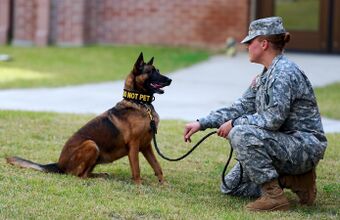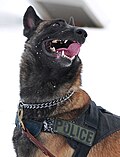Rage syndrome
Topic: Medicine
 From HandWiki - Reading time: 7 min
From HandWiki - Reading time: 7 min
| Rage syndrome | |
|---|---|
| Other names | A22, episodic dyscontrol, stimulus-responsive psychomotor epilepsy, Mental lapse aggression syndrome |
 | |
| The Malinois was the first breed to have a specific genetic polymorphism linked to rage syndrome. | |
| Specialty | Neurology |
| Symptoms |
|
| Complications | Behavioral euthanasia |
| Usual onset | 1–3 years old |
| Duration | Lifelong |
| Causes | Unknown |
| Risk factors | PolyA(22) (in Malinois), DAT-VNTR (in Malinois), likely other genetic factors, breed, other seizures |
| Diagnostic method | EEG, with complete exclusion of other medical conditions via thorough medical testing |
| Differential diagnosis | Any untreated illness (Pathophysiological aggression) or behavioral condition |
| Prevention | Selective breeding, Health testing (PolyA(22) test, in Malinois) |
| Management | Anticonvulsants, muzzling, barrier use, lifestyle changes |
| Medication | Antiepileptic drugs (Phenobarbital) |
| Prognosis | Generally poor |
Rage syndrome is a rare seizure disorder in dogs, characterized by explosive aggression.[1][2][3]
It is frequently confused with idiopathic aggression, a term for aggression with no identifiable cause. Rage syndrome is most often a misdiagnosis of dogs with an unrelated, but more common, form of aggression. Although the scientific evidence is limited, it is thought to be genetic in origin, and is heritable. [4] It is treated with antiepileptics.[5]
Names
Rage syndrome has been known by a variety of names since it was discovered.[1][3] Rage syndrome is a colloquial term most often preferred by dog trainers, handlers, and some behavior consultants. Alternative names used by researchers, veterinary scientists, and behavior specialists include mental lapse syndrome (MLS) and episodic dyscontrol.[1]
Rage syndrome is also sometimes termed a form of epilepsy, particularly limbic epilepsy.[6][7] The term limbic epilepsy for rage syndrome has been used synonymously with the terms psychomotor epilepsy, automatic epilepsy, rhinencephalic epilepsy, behavioral epilepsy, temporal lobe epilepsy, and autonomic epilepsy.[6][7][8][9][10] In addition, depending on the professional's discretion the word "seizure" may be substituted for "epilepsy" in a given study or resource.[7] Edward B. Breitschwerdt, a researcher and veterinarian, wrote that this "profusion of synonyms makes it difficult to clearly ascertain the results of either clinical or research investigations of limbic epilepsy in the dog".[6]
Rage syndrome is frequently confused with idiopathic aggression, a term for aggression with no identifiable cause, due to sharing a name with it in its earliest studies before being identified as a discrete condition. In early research Rage syndrome is sometimes referred to as sudden-onset idiopathic aggression (SOIA) to distinguish it from idiopathic disease, and later as sudden-onset aggression (SOA).
Rage syndrome has no medical connection to rabies, for which its name is sometimes mistaken (from the Latin noun "rabiēs", meaning "rage").
Characteristics
Aggression in rage syndrome is characterized by its severity and often fatal to dogs, animals, or people it is targeted towards.[1] Episodes may cause life-threatening injuries and result in disability or disfigurement.[1]
Dogs with rage syndrome typically have their first rage episode during adolescence, between 1 and 3 years old, similar to dogs with idiopathic epilepsy.[1]
Interictal EEGs under general anesthesia typically show low-voltage rapid discharges characteristic of focal seizures.[1][11][12] Seizure foci are in the temporal lobe, most often the left temporal lobe.[1][13]
Outcomes
Prognosis for treatment of rage syndrome is guarded.[1] It is treated with antiepileptics.[5]
Risk factors
Associated breeds
English Springer Spaniel
The English Springer Spaniel is the origin of the term "Springer Rage" frequently used in the 70s and 80s.
English Springer Spaniels were the breed most often referred to dog behavior consultants for aggression in the 80s.[2][14][15]
Pat Miller wrote in Beware of the Dog: Positive Solutions for Aggressive Behavior in Dogs in 2017: "[Rage syndrome] captured the imagination of the dog world, and soon every dog with episodes of sudden, explosive aggression was tagged with the unfortunate "rage syndrome" label, especially if it was a Spaniel of any type."[16]
Other breeds
Bull terriers have also been used in research studies on breed-specific hereditary focal seizures, sometimes including aggressive symptoms.[17]
Diagnosis
Rage syndrome is diagnosed by EEG.[1][4][13]
Differential diagnosis
Endocrine
Thyroid function is tested during typical diagnostic workups as thyroid conditions, most commonly hypo- and hyperthyroidism, have been suggested to cause pathophysiological aggression that may present similarly to Rage syndrome.[1][18]
In other animals
In other mammals
In 2002 a 4-month-old tigress was reported with symptoms analogous to Rage syndrome.[13] The tigress had episodes between 30 seconds and a minute long of explosive self-directed aggression and self-mutilation, in addition to occasional generalized tonic-clonic seizures and both focal and generalized neurologic symptoms such as episodes of continuously walking in circles to the right and epileptic blindness. Her EEG showed left frontal-temporal epileptiform activity, confirming a diagnosis of complex partial seizures. Cerebrospinal fluid testing, hematologic testing, serotologic testing, and serum biochemistry profile were all normal aside from faintly elevated CSF proteins. The tigress was the result of a consanguineous breeding and one of her littermates was diagnosed with generalized seizures. She was successfully treated with Phenobarbital (2.5 mg/kg by mouth twice a day, bringing her within the therapeutic range at a blood concentration of 24 mg/dl).[13]
Superseded theories
In 1980 it was suggested that electroconvulsive therapy, prefrontal lobotomy, and partial cerebral hypoxia (hypoxic-anoxic brain injury) be used to treat rage syndrome.[1] A 1974 study on prefrontal lobotomy of aggressive dogs found that 50% of lobotomized dogs died of complications.[19] Surviving dogs developed seizures, fecal and urinary incontinence, confusion, memory loss, seromas, emotional dysregulation, focal neurologic symptoms, weakness, and weight loss.[19] 40% of surviving dogs did not have a reduction in existing aggression, and some dogs' aggression worsened after the procedure.[19] The treatments were described as heroic measures which caused further damage to the dogs' health but were undertaken as a last resort to preserve the lives of the dogs. Multiple dogs which did not die from the procedure itself were euthanized anyways.[19]
See also
- Phenobarbital
- List of fatal dog attacks
- Causes of seizures
- Animal euthanasia
References
- ↑ 1.00 1.01 1.02 1.03 1.04 1.05 1.06 1.07 1.08 1.09 1.10 1.11 B.V., Beaver (1980). "Mental lapse aggression syndrome [Dogs."]. Journal American Animal Hospital Association: 937-939. ISSN 0587-2871. https://agris.fao.org/agris-search/search.do?recordID=US19820738566. Retrieved 21 May 2023.
- ↑ 2.0 2.1 Reisner, Ilana R.; Houpt, Katherine A.; Shofer, Frances S. (1 Nov 2005). "National survey of owner-directed aggression in English Springer Spaniels". Journal of the American Veterinary Medical Association 227 (10): 1594–1603. doi:10.2460/javma.2005.227.1594. ISSN 0003-1488. PMID 16313036.
- ↑ 3.0 3.1 Amat, Marta; Manteca, Xavier; Mariotti, Valentina M.; Ruiz de la Torre, José Luís; Fatjó, Jaume (2009). "Aggressive behavior in the English cocker spaniel". Journal of Veterinary Behavior 4 (3): 111–117. doi:10.1016/j.jveb.2008.08.010. ISSN 1558-7878.
- ↑ 4.0 4.1 Dodman; Miczek, K. A.; Knowles, K.; Thalhammer, J. G.; Shuster, L. (1992). "Phenobarbital-responsive episodic dyscontrol (rage) in dogs". Journal of the American Veterinary Medical Association 201 (10): 1580–1583. PMID 1289339.
- ↑ 5.0 5.1 Bowen, Jon; Heath, Sarah (October 2005). Behaviour problems in small animals: practical advice for the veterinary team (Paperback ed.). Saunders Ltd. p. 55. ISBN 0-7020-2767-7. https://archive.org/details/behaviourproblem00bowe.
- ↑ 6.0 6.1 6.2 E.B., Breitschwerdt; J.E., Breazile; J.J., Broadhurst (1979). "Clinical and electroencepahlographic findings associated with ten cases of suspected limbic epilepsy in the dog.". Journal American Animal Hospital Association. ISSN 0587-2871. https://agris.fao.org/agris-search/search.do?recordID=US19800522296. Retrieved 4 Jun 2023.
- ↑ 7.0 7.1 7.2 Hoerlein, B. F. (1971). Canine Neurology, Diagnosis and Treatment. Saunders. ISBN 0-7216-4711-1.
- ↑ Lennox, W. G. (1 Sep 1951). "Phenomena and Correlates of the Psychomotor Triad". Neurology 1 (9–10): 357–371. doi:10.1212/wnl.1.9-10.357. ISSN 0028-3878. PMID 14863538.
- ↑ Ettinger, S.J. (1975). Textbook of Veterinary Internal Medicine: Diseases of the Dog and Cat. Saunders. p. 375-400. ISBN 978-0-7216-3425-8. https://books.google.com/books?id=tUptAAAAMAAJ. Retrieved 4 Jun 2023.
- ↑ Parry, H.B. (15 Jan 1949). "Epileptic states in the dog, with special reference to canine-hysteria". The Veterinary Record 61 (3): 23–31. ISSN 0042-4900. PMID 18111927. https://pubmed.ncbi.nlm.nih.gov/18111927/. Retrieved 4 Jun 2023.
- ↑ de Curtis, Marco; Gnatkovsky, Vadym (2009). "Reevaluating the mechanisms of focal ictogenesis: The role of low-voltage fast activity". Epilepsia 50 (12): 2514–2525. doi:10.1111/j.1528-1167.2009.02249.x. ISSN 0013-9580. PMID 19674056.
- ↑ Wendling, F.; Bartolomei, F.; Bellanger, J. J.; Bourien, J.; Chauvel, P. (2003). "Epileptic fast intracerebral EEG activity: evidence for spatial decorrelation at seizure onset". Brain 126 (6): 1449–1459. doi:10.1093/brain/awg144. ISSN 1460-2156. PMID 12764064.
- ↑ 13.0 13.1 13.2 13.3 L, Bergamasco; A, Accatino; S, Cizinauskas; A, Jaggy (2003). "Bit-mapped quantitative EEG analysis in a tiger (Tiger felis) with partial seizures: a case report". Functional Neurology 18 (1): 35–38. ISSN 0393-5264. PMID 12760412. https://pubmed.ncbi.nlm.nih.gov/12760412/. Retrieved 22 May 2023.
- ↑ Landsberg, G.M. (1991). "The distribution of canine behavior cases at three behavior referral practices". Veterinary Medicine. ISSN 8750-7943. https://agris.fao.org/agris-search/search.do?recordID=US9145217. Retrieved 3 Jun 2023.
- ↑ IR, Reisner; HN, Erb; KA, Houpt (15 September 1994). "Risk factors for behavior-related euthanasia among dominant-aggressive dogs: 110 cases (1989-1992)". Journal of the American Veterinary Medical Association 205 (6): 855–863. ISSN 0003-1488. PMID 7829381. https://pubmed.ncbi.nlm.nih.gov/7829381/. Retrieved 3 Jun 2023.
- ↑ Miller, P. (2016). Beware of the Dog: Positive Solutions for Aggressive Behavior in Dogs. Dogwise Publishing. ISBN 978-1-61781-193-7. https://books.google.com/books?id=JSUpvgAACAAJ. Retrieved 4 Jun 2023.
- ↑ NH, Dodman; KE, Knowles; L, Shuster; AA, Moon-Fanelli; AS, Tidwell; CL, Keen (March 1996). "Behavioral changes associated with suspected complex partial seizures in bull terriers". Journal of the American Veterinary Medical Association 208 (5): 688–691. ISSN 0003-1488. PMID 8617623. https://pubmed.ncbi.nlm.nih.gov/8617623/. Retrieved 20 Jun 2023.
- ↑ Fatjó, J.; Stub, C.; Manteca, X. (2002). "Four cases of aggression and hypothyroidism in dogs". Veterinary Record 151 (18): 547–548. doi:10.1136/vr.151.18.547. ISSN 0042-4900. PMID 12448494.
- ↑ 19.0 19.1 19.2 19.3 BD, Allen; JF, Cummings; A, De Lahunta (April 1974). "The effects of prefrontal lobotomy on aggressive behavior in dogs". The Cornell Veterinarian 64 (2): 201–216. ISSN 0010-8901. PMID 4207830. https://pubmed.ncbi.nlm.nih.gov/4207830/. Retrieved 4 Jun 2023.
Further reading
- Van Buren, Samantha L.; Oberbauer, Anita M.; Minor, Katie M.; Belanger, Janelle M.; Furrow, Eva (3 Jun 2021). "Association analysis of dopamine transporter gene ( SLC6A3 ) variants with risk for seizures and aggression in Border Collies". Animal Genetics 52 (4): 573–574. doi:10.1111/age.13097. ISSN 0268-9146. PMID 34081804.
- Lit, Lisa; Belanger, Janelle M.; Boehm, Debby; Lybarger, Nathan; Oberbauer, Anita M. (23 Dec 2013). "Differences in Behavior and Activity Associated with a Poly(A) Expansion in the Dopamine Transporter in Belgian Malinois". PLOS ONE 8 (12): e82948. doi:10.1371/journal.pone.0082948. ISSN 1932-6203. PMID 24376613. Bibcode: 2013PLoSO...882948L.
- Lit, Lisa; Belanger, Janelle M; Boehm, Debby; Lybarger, Nathan; Haverbeke, Anouck; Diederich, Claire; Oberbauer, Anita M (30 May 2013). "Characterization of a dopamine transporter polymorphism and behavior in Belgian Malinois". BMC Genetics 14 (1): 45. doi:10.1186/1471-2156-14-45. ISSN 1471-2156. PMID 23718893.
- Lit, Lisa; Belanger, J. M.; Boehm, D.; Lybarger, N.; Oberbauer, A. M. (9 Apr 2013). "Dopamine transporter single nucleotide polymorphisms (SNPs) in Belgian Malinois dogs". Animal Genetics 44 (5): 604–605. doi:10.1111/age.12040. ISSN 0268-9146. PMID 23565797. https://onlinelibrary.wiley.com/doi/10.1111/age.12040.
- Dodman, NH; Knowles, KE; Shuster, L; Moon-Fanelli, AA; Tidwell, AS; Keen, CL (1 Mar 1996). "Behavioral changes associated with suspected complex partial seizures in bull terriers". Journal of the American Veterinary Medical Association 208 (5): 688–691. ISSN 0003-1488. PMID 8617623. https://pubmed.ncbi.nlm.nih.gov/8617623/. Retrieved 4 Jun 2023.
- Dodman; Miczek, K. A.; Knowles, K.; Thalhammer, J. G.; Shuster, L. (1992). "Phenobarbital-responsive episodic dyscontrol (rage) in dogs". Journal of the American Veterinary Medical Association 201 (10): 1580–1583. PMID 1289339. https://pubmed.ncbi.nlm.nih.gov/1289339/. Retrieved 22 May 2023.
- B.V., Beaver (1980). "Mental lapse aggression syndrome [Dogs."]. Journal American Animal Hospital Association 16 (6): 937-939. ISSN 0587-2871. https://archive.org/details/sim_journal-of-the-american-animal-hospital-association_november-december-1980_16_6/mode/1up?view=theater. Retrieved 22 May 2023.
 |
 KSF
KSF


